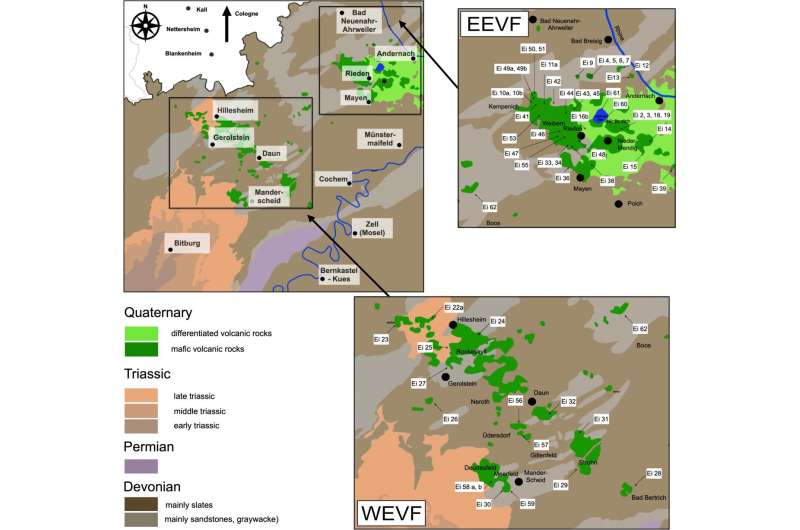This article has been reviewed according to Science X's editorial process and policies. Editors have highlighted the following attributes while ensuring the content's credibility:
fact-checked
trusted source
proofread
Researchers examine rocks in the Eifel region to investigate volcanic activity

A team of geoscientists have analyzed the composition of rocks in the Eifel, a volcanic region encompassing parts of western Germany, Belgium and Luxembourg. They discovered that it differs depending on the region.
Data from volcanic rocks from the eastern Eifel and older rock samples from the western Eifel (older than 80,000 years) indicate magma sources in the Earth's upper mantle that are no deeper than 70 kilometers. Samples from the West Eifel that are younger than 80,000 years originate from a deeper magma source, possibly due to the rise of a hot mantle plume—an area of the Earth's mantle that is hotter than the surrounding mantle rock and contains melt components.
For this study, the researchers, including many students, examined numerous young volcanoes in the Eifel in order to gain new insights into the sources of volcanism at a depth of 50 to 100 kilometers. The results were published in the journal Contributions to Mineralogy and Petrology.
The research group's data analysis also shows different volcanic pulses over time. Over the last hundreds of thousands of years, Eifel volcanism has apparently awoken from its slumber repeatedly.
The volcanic activity of the Eifel is essentially divided into two main phases of activity. The first phase began around 45 million years ago and formed the landscape of the Hocheifel volcanic field around the Hohe Acht, the highest mountain in the Eifel. The second, much more recent phase began around 1 million years ago and ended with the eruption around 10,900 years ago.
The huge explosion of the Laacher See volcano 13,000 years ago in particular had a major impact on the climate and landscape development in central Europe. The consequences of the eruption were deposits of volcanic material several meters thick in the Rhine Valley, volcanic ash that was transported up to 1,000 kilometers by winds, and a significant drop in temperature in the northern hemisphere.
While the High Eifel volcanic field has been very well characterized from a geological and especially geochemical perspective, comparable data on the younger, still active East and West Eifel volcanic fields has been lacking until now. State-of-the-art geochemical data from the current study provide the basis for further insights into the origin of the magma and the potential trigger for central European volcanism.
The study summarizes the results of more than 15 years of intensive research in Cologne as part of Bachelor's, Master's and doctoral theses at the University of Cologne's Institute of Geology and Mineralogy and provides further evidence of the ongoing volcanic activity of the Eifel.
More information: Mike W. Jansen et al, Petrogenesis of volcanic rocks from the Quaternary Eifel volcanic fields, Germany: detailed insights from combined trace-element and Sr–Nd–Hf–Pb–Os isotope data, Contributions to Mineralogy and Petrology (2024). DOI: 10.1007/s00410-024-02137-w
Provided by University of Cologne





















